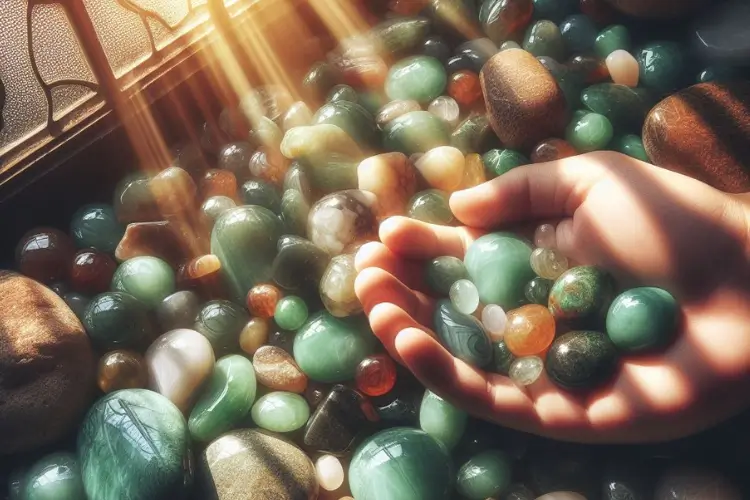Latin America and China have the most cultural significance of Jade. People have been using it as a gemstone for centuries. There are different types of Jade stones in the market.
Finding the one with healing benefits can be tricky. We will teach you how to tell if jade is real or fake to help you find authentic crystals and enjoy healing benefits.
How to Tell If Jade Is Real?
There is a high demand for Jade in the market.
It is due to centuries of the cultural and spiritual significance of the Jade.
Some sellers try to make counterfeit Jade from plastic or glass material.
To find the authenticity of the Jade stone, you need to learn about different types of Jade.
Jade stones can range from light-green to deep-black colors.
You may find authentic yellowish-gray jade in the market also.
Green is more abundantly available in the market.
What Are the Types of Jade?
Some people think that there are only two jade stones.
They classify them as Nephrite and Jadite.
These are not two jade stones but two categories of minerals that can have many different types of Jades.
You can estimate the price of jade better when you know the differences between these stones.
There are some differences in the price and structure of the two types of jades.
You will find some details of these differences here.
Jadeite
Jadeite is the stone responsible for the high price of this category.
Some jadeite stones are available in gray or blue color also.
The most important ones are the gree Jadite stones.
The green variation with the emerald color is known as Imperial Jade.
The Imperial word was attached to the Jade due to its use by the Final Chinese Emporer.
He was fascinated by Jade as he used it himself.
He also collected all the Jade stones wherever he found them.
Jade was more important than treasures for him.
Jadeite has a hardness score of 6 to 7 on the Moh Hardness Scale.
It has more durability than Nephrite stones.
You can scratch calcite with the Jadeite.
It is impossible to scratch quartz with Jadeite as they have a similar hardness profile.
Nephrite
Nephrite is a type of jade with a bright luster.
You can get it in many different colors.
You will mostly get it in a green and gray conjugation color.
Some parts of the stones can also have a white and yellow color.
Some light can pass from the stone due to its translucent properties.
You will not see the other side of the stone as these are not transparent.
You will also get cloudy color in the stone with the fibrous crystal structure.
Nephrite jades can get a specific color shade if you use the colored polishing material or specific polishing techniques that impart pigments on the stone’s surface.
Nephrite has a lower hardness score than Jadite.
It has a hardness score of 6 to 6.5.
What Are the Key Differences Between Identifying Real and Fake Jade and Pyrite?
Identifying real pyrite from fake can be challenging, especially with jade. With jade, look for a waxy, glassy sheen and examine the color.
Real jade will have a deeper, more vibrant color. For pyrite, the most obvious difference is the weight; real pyrite is much heavier than its counterfeit counterparts.
How to Tell if Jade Is Real or Fake?
To tell if jade is real or fake, scratch the surface with a sharp object such as a knife. If the knife scratches the surface, then the jade stone is not real. The amethyst stone will nick jade easily and no powder should come off after the scraping. This is a good way to tell that a jade gemstone is real and not fake.
It is better to learn how to tell if jade is real or fake to find authentic gemstones from the market.
It is better to start with the texture analysis.
Light and toss tests can also give crucial hints about the Jade authenticity.
Some people do a scratch test to confirm the stone’s hardness.
Experts check the authenticity by clicking the test as they can differentiate between the stone’s sound.
You can confirm Jade’s identity with the temperature test.
1. To Tell if Jade Is Real or Fake, Check the Texture
A jade gemstone can occur in different colors.
You will never find a Jade in the market with a dull appearance.
It always has a shiny surface with some light passing ability.
Jade always passes some light as it does not occur in complete opaque stone form.
A lack of sheen on the jade surface indicates the seller used chemicals or dye to alter the Jade.
You should not see bubbles in the Jade with naked eyes.
The stone is made from glass material if you can see large bubbles.
There is a water-like shine on the surface of the jade.
Jade with a low level of translucency is cheaper.
2. To Tell if Jade Is Real or Fake, Conduct the Light Test
When checking with the light test, you should be able to find the consistency and inclusions in the jade stones.
It is one of the best methods to find Jade’s authenticity.
You can identify the authentic jade by placing it on the light source.
You can see the stone’s internal structure when you put it on the light source.
The light should change color at some points due to internal variations.
Counterfeit stones can have blemishes on the deeper layers.
It may also have flawless color.
You will not observe light color variations in the fake Jade stones.
3. To Tell if Jade Is Real or Fake, Do the Toss Test
A toss test can give you a hint about the authenticity of the Jade stones.
You can toss the Jade in the air and catch it to feel its weight.
It should feel heavy when you catch it.
Jade has a higher density.
Nephrite stones can have a specific gravity of 3 grams per cubic centimeter.
Jadeite has a higher density as it can have a specific gravity of 3.38 grams per cubic centimeter weight.
Some sellers make counterfeit Jade from heavy plastic material to scam people.
You can combine the toss test with a scratch test to get better results.
4. To Tell if Jade Is Real or Fake, Conduct the Clicking Test
You need sharp ears to do the clicking test on Jade.
You can get a coin or metallic object to start the clicking test.
You can hit the coin to the jade crystal. It will produce a sound.
If you hear a deep sound with a single click, it is fake jade.
These counterfeit jade stones consist of glass, plastic, or cloth material.
You will hear a sharp sound when you hit the authentic Jade stones.
The sound should also resonate for a short time.
A resonating sound indicates you have the authentic Jade stone.
5. To Tell if Jade Is Real or Fake, Do the Scratch Test
A Scratch test is one of the best ways to confirm the stone’s authenticity.
It is possible to identify the Jade with the scratch test as it has a high hardness core.
Jadeite has a hardness score of 7 on the Moh Hardness Scale.
Steel has a hardness score of 5. You cannot scratch Jade with the knife.
The glass should not make a scratch on the Jade surface.
You can take a glass piece and use Jade to scratch its surface.
You have n authentic stone if it makes a scratch on the glass surface.
Rubbing it on the glass will scratch the surface of Jade when it is a counterfeit stone.
6. To Tell if Jade Is Real or Fake, Check Jade Temperature
Jade is a heat reflecting stone.
It takes a long time to heat the Jade stones.
You can test the jade authenticity by holding it in your hand.
Jade should feel cold to touch.
You can keep it in your hand for some time.
You will not feel any temperature difference.
It will lose heat when you place it back for a few seconds.
You can find the authenticity with this method if you have a better temperature sense.
To Summarize: How to Tell if Jade Is Real or Fake
You can learn about different types of Jade stones to find authentic ones.
Sellers try to make counterfeit jade from plastic and glass materials.
You can keep some points about the authenticity of jade in mind to get the results of authenticity tests with accuracy.
- Nephrite and Jadeite are two types of Jade stones.
- Authentic jade has some color variations in the deeper layers.
- There are no bubbles visible to the naked eyes in the Jade.
- The toss test can give you an idea about the specific gravity of Jade.
- The Scratch test will help you find the stone’s identity as Jade has a high hardness score.
- Jade will feel cooler than the surrounding objects.

